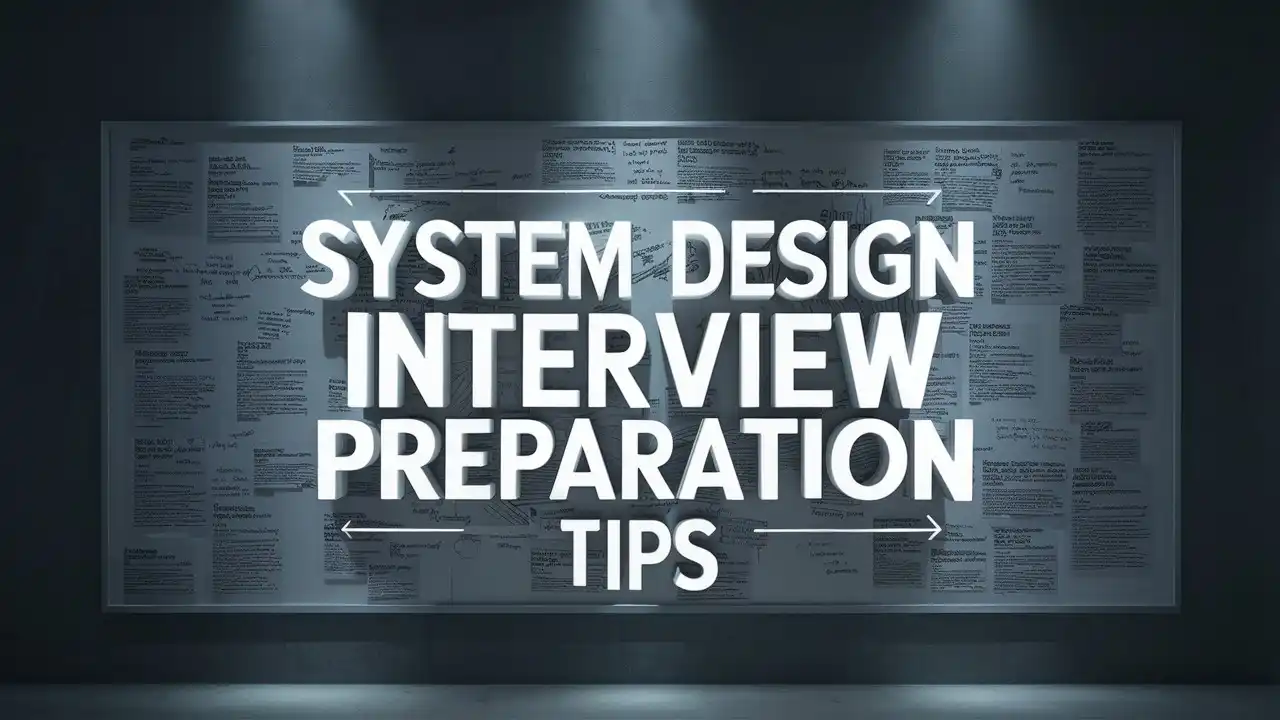Introduction
In the rapidly evolving landscape of software engineering in 2025, system design interviews have become a critical component of the hiring process for top-tier tech companies. These interviews assess your ability to design scalable, efficient, and robust systems, mirroring real-world engineering challenges. Excelling in system design interviews not only demonstrates your technical prowess but also showcases your problem-solving abilities and strategic thinking.
This comprehensive guide provides system design interview preparation tips in 2025, offering actionable strategies, essential resources, and best practices to help you ace your interviews. Whether you’re aiming for a position at a tech giant like FAANG or a dynamic startup, these tips will equip you with the knowledge and confidence to design systems that stand out.
💡 Tip: Begin your preparation early and adopt a structured approach. Consistent practice and continuous learning are key to mastering system design interviews.
🧐 1. Understanding System Design Interviews
🎯 Purpose of System Design Interviews
System design interviews evaluate your ability to architect complex systems, considering aspects like scalability, reliability, maintainability, and efficiency. Employers use these interviews to gauge how you approach large-scale problems, make design decisions, and articulate your thought process.
🔍 What Interviewers Look For
- Problem-Solving Skills: Ability to break down complex problems into manageable components.
- Technical Knowledge: Understanding of fundamental concepts like load balancing, caching, database sharding, and microservices.
- Scalability and Efficiency: Designing systems that can handle growth without compromising performance.
- Communication: Clearly articulating ideas, assumptions, and design choices.
- Trade-Off Analysis: Making informed decisions by weighing the pros and cons of different approaches.
📌 Quick Tip: Familiarize yourself with the typical structure of system design interviews, including open-ended questions and scenario-based problems.
🧠 2. Core Concepts to Master
🌐 Scalability
Design systems that can handle increasing loads gracefully. Understand horizontal vs. vertical scaling, load balancing techniques, and how to distribute traffic effectively.
💾 Databases
Know the differences between SQL and NoSQL databases, database sharding, indexing, and transaction management. Understand when to use each type based on system requirements.
🚀 Caching
Implement caching strategies to reduce latency and improve system performance. Familiarize yourself with caching layers like CDN, in-memory caches (Redis, Memcached), and client-side caching.
🔄 Consistency and Availability
Grasp the CAP theorem and how it applies to distributed systems. Learn about consistency models, replication strategies, and fault tolerance mechanisms.
🛠️ Microservices and Monoliths
Understand the pros and cons of microservices architecture versus monolithic architecture. Know how to design services, manage inter-service communication, and handle service discovery.
🕸️ Networking Protocols
Basic knowledge of networking protocols like HTTP/HTTPS, TCP/IP, and DNS is essential for designing robust systems.
📊 Data Structures and Algorithms
Strong foundational knowledge helps in optimizing system components and solving design challenges efficiently.
🔧 Pro Tip: Create mind maps for each core concept to visualize their interconnections and applications within system design.
📚 3. Study Resources and Materials
📖 Books
- “Designing Data-Intensive Applications” by Martin Kleppmann: An in-depth look at modern data systems and architecture.
- “System Design Interview – An Insider’s Guide” by Alex Xu: Practical guide with real-world system design problems.
- “Site Reliability Engineering” by Niall Richard Murphy, et al.: Insights into maintaining scalable and reliable systems.
💻 Online Courses
- Grokking the System Design Interview: Structured lessons on common system design questions.
- Coursera – Cloud Computing Specialization: Comprehensive understanding of cloud infrastructure and services.
- Udemy – Mastering System Design: Practical approach to designing scalable systems.
🌐 Websites and Blogs
- System Design Primer (GitHub): Comprehensive repository of system design resources and examples.
- High Scalability: Articles and case studies on scalable system architectures.
- Medium – Towards Data Science: Articles on system design, data engineering, and scalable architectures.
🎥 Video Tutorials
- YouTube – Tech Dummies Narendra L: Detailed system design interview preparation videos.
- System Design Interviews by Gaurav Sen: In-depth explanations of system design concepts and interview strategies.
📚 Advice: Diversify your learning materials to gain different perspectives and deepen your understanding of complex concepts.
🛠️ 4. Practical Preparation Strategies
📝 Structured Approach to Learning
Adopt a systematic approach to cover all essential topics. Start with foundational concepts and gradually move to advanced topics, ensuring a comprehensive understanding.
🗂️ Categorize System Design Problems
Classify common system design problems into categories such as web applications, real-time systems, data processing, and distributed systems. This helps in identifying patterns and applying relevant solutions.
🧩 Break Down Problems
During interviews, break down the problem into smaller components. Address each part methodically, ensuring that your design is both comprehensive and cohesive.
🛠️ Hands-On Practice
Implement your designs using code or architecture diagrams. Building prototypes or mock systems can reinforce your understanding and highlight potential challenges.
📊 Analyze Real-World Systems
Study the architecture of existing systems like Twitter, Netflix, or Amazon. Understanding how large-scale systems are built provides practical insights and inspiration for your designs.
🚀 Tip: Regularly sketch system architectures on a whiteboard or paper to simulate interview conditions and improve your ability to visualize complex systems.
🧩 5. Common System Design Questions and How to Approach Them
📱 Designing a Social Media Platform
Approach:
- Requirements Gathering: Define functional and non-functional requirements.
- High-Level Architecture: Outline major components like user service, post service, feed service, etc.
- Database Design: Choose appropriate databases and design schemas.
- Scalability Considerations: Implement load balancing, caching, and data partitioning.
- Trade-Offs: Discuss the pros and cons of different approaches.
📦 Designing a URL Shortener
Approach:
- Requirements: Shortening URLs, redirecting, handling high traffic.
- Unique ID Generation: Implement hashing or base conversion techniques.
- Database Design: Efficient storage and retrieval of URLs.
- Scalability: Use caching layers and distributed databases.
- Additional Features: Analytics, custom aliases, expiration dates.
🛒 Designing an E-Commerce System
Approach:
- Requirements: User management, product catalog, shopping cart, payment processing.
- Microservices Architecture: Separate services for inventory, orders, payments, etc.
- Database Management: Use SQL for transactions and NoSQL for catalogs.
- Scalability and Reliability: Implement load balancers, caching, and redundant systems.
- Security: Ensure secure transactions and data protection.
🔄 Designing a Real-Time Chat Application
Approach:
- Requirements: Real-time messaging, group chats, message history.
- Real-Time Communication: Utilize WebSockets or similar protocols.
- Data Storage: Choose databases for storing messages and user data.
- Scalability: Implement horizontal scaling and message queues.
- Additional Features: Typing indicators, read receipts, file sharing.
📌 Example: When designing a social media platform, emphasize the importance of a scalable feed generation system and real-time notifications to enhance user engagement.
🗣️ 6. Mock Interviews and Feedback
🎤 Conduct Mock Interviews
Simulate real interview scenarios by conducting mock interviews with peers or mentors. This practice helps in refining your approach, improving communication skills, and managing interview anxiety.
📝 Seek Constructive Feedback
After each mock interview, seek detailed feedback on your performance. Identify areas of strength and pinpoint aspects that require improvement, such as clarity of thought, depth of knowledge, or presentation skills.
🕒 Time Management
Practice solving system design problems within a set timeframe. Efficient time management ensures that you cover all essential aspects of the design without getting bogged down by details.
📈 Track Your Progress
Maintain a journal or spreadsheet to track the system design problems you’ve tackled, the feedback received, and the improvements made. This helps in monitoring your growth and identifying recurring challenges.
🤝 Pro Tip: Pair up with a study buddy to conduct regular mock interviews and provide mutual support throughout the preparation journey.
💡 7. Tips and Tricks for Success
🌟 Develop a Consistent Study Schedule
Allocate dedicated time each day or week for system design preparation. Consistency ensures steady progress and reinforces learning.
🧩 Understand the Big Picture
Focus on understanding how different components of a system interact rather than getting lost in granular details. This holistic view aids in designing cohesive and efficient systems.
💬 Communicate Clearly
Articulate your thought process clearly and concisely during interviews. Use diagrams to visualize your design and ensure that the interviewer can follow your logic.
🔄 Iterate and Refine
Be open to revising your designs based on feedback or new insights. Iterative improvement leads to more robust and optimized system architectures.
📚 Stay Updated with Industry Trends
Keep abreast of the latest developments in technology and system design practices. Understanding current trends ensures that your designs incorporate modern solutions and best practices.
💡 Quick Tip: Always start with a high-level overview before diving into specific components. This approach provides context and sets the stage for detailed discussions.
Conclusion
Mastering system design interview preparation tips in 2025 is essential for securing a coveted software engineering role at top-tier companies. By understanding the core concepts, utilizing the right resources, adopting practical strategies, and engaging in continuous practice, you can build the expertise needed to design scalable and efficient systems. Remember to communicate your ideas clearly, seek constructive feedback, and stay updated with industry trends to stay ahead in the competitive job market.
🚀 Final Tip: Embrace a growth mindset. View each interview as an opportunity to learn and refine your system design skills, ensuring long-term success in your engineering career.


















